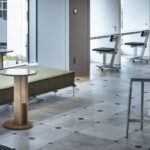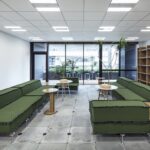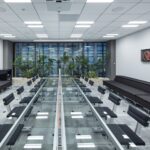The COVID-19 pandemic has reshaped our perceptions of the traditional office environment. With the rise of remote work and online meetings, the distinction between home and office has blurred, challenging conventional notions of workspace design. In response to these shifts, the HAKUHODO Gravity Office, designed by DDAA, reimagines the office as a dynamic and adaptable space that accommodates diverse work styles and preferences.

Redefining the Office
As remote work becomes increasingly prevalent, individuals seek environments that offer both flexibility and social interaction. The Gravity Office acknowledges this complexity by providing a range of options, from private workspaces to collaborative areas, each tailored to different needs and moods. By embracing social diversity and fluidity, the office aims to create a vibrant and inclusive work environment.
Design Concept
At the core of the Gravity Office is the concept of “mingle” – bringing people together while respecting their individuality. Inspired by the interplay of colors in a freshly made café latte or marbled patterns, the design encourages interaction and collaboration. By integrating various functions along a gradient continuum, the office blurs the boundaries between work and leisure, fostering a sense of community and belonging.

Spatial Organization
The office layout reflects the diverse needs of its occupants, with zones ranging from individual workstations to communal lounges. Rather than compartmentalizing different activities, the design emphasizes fluidity and connectivity, allowing individuals to transition seamlessly between focused work and social interaction. By creating a continuum of spaces that cater to different preferences, the office promotes productivity and well-being.
Leveraging Existing Systems
Innovative approaches to materials and construction enable the Gravity Office to maximize efficiency and minimize waste. By repurposing existing floor units as furniture and incorporating off-the-shelf materials, the design reduces environmental impact while enhancing aesthetic appeal. Resin fixtures, symbolizing the concepts of “gravity” and “mingle,” add a playful yet sophisticated touch to the interior.

Conclusion
The HAKUHODO Gravity Office represents a bold reimagining of the traditional office space. By embracing social diversity, fluidity, and sustainability, the design offers a compelling vision for the future of work. As organizations navigate the evolving landscape of work culture, the Gravity Office serves as a model for creating dynamic, inclusive, and inspiring environments that empower individuals to thrive.
















